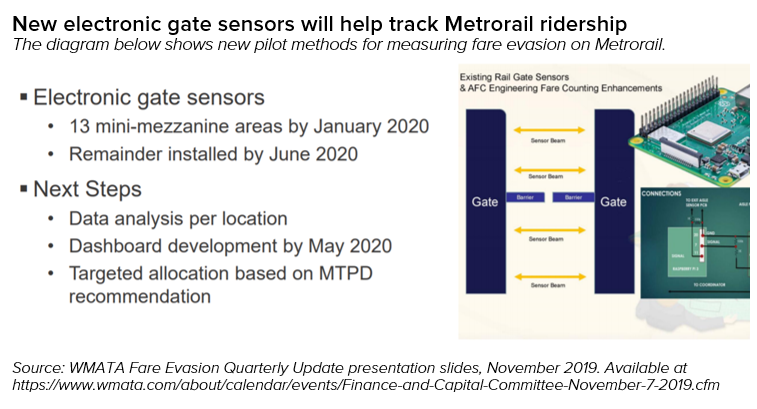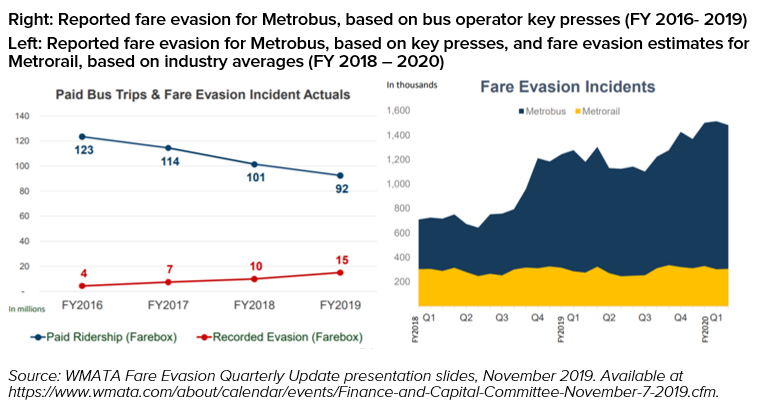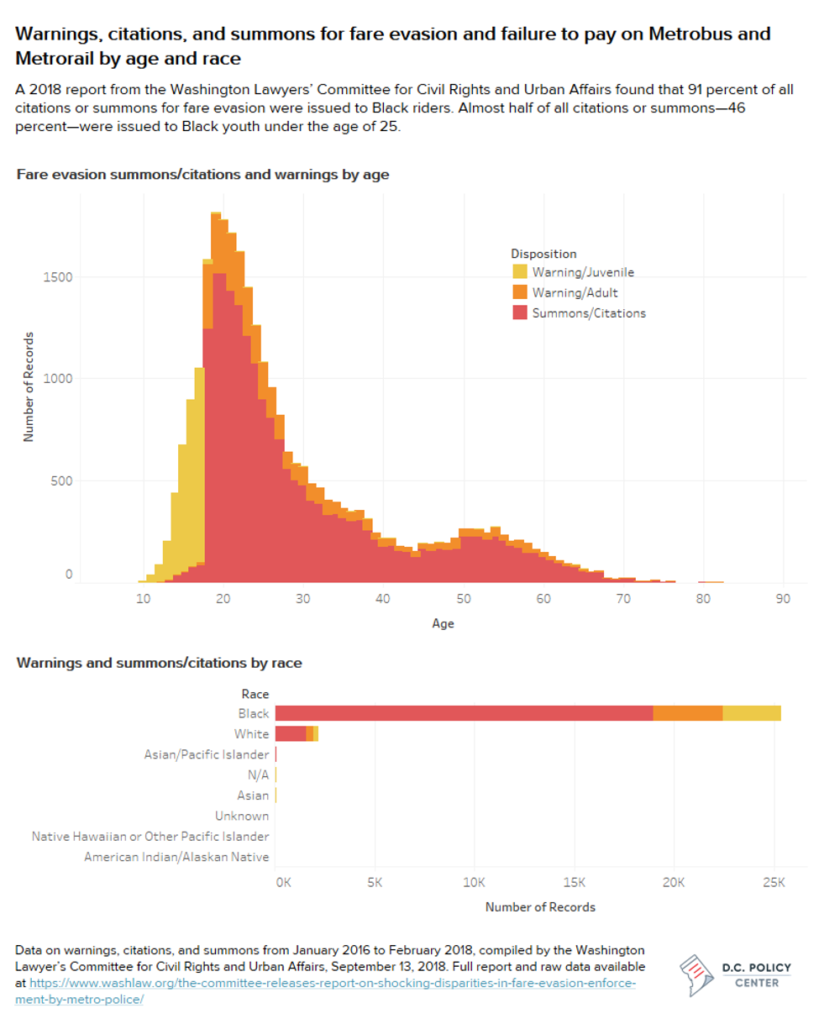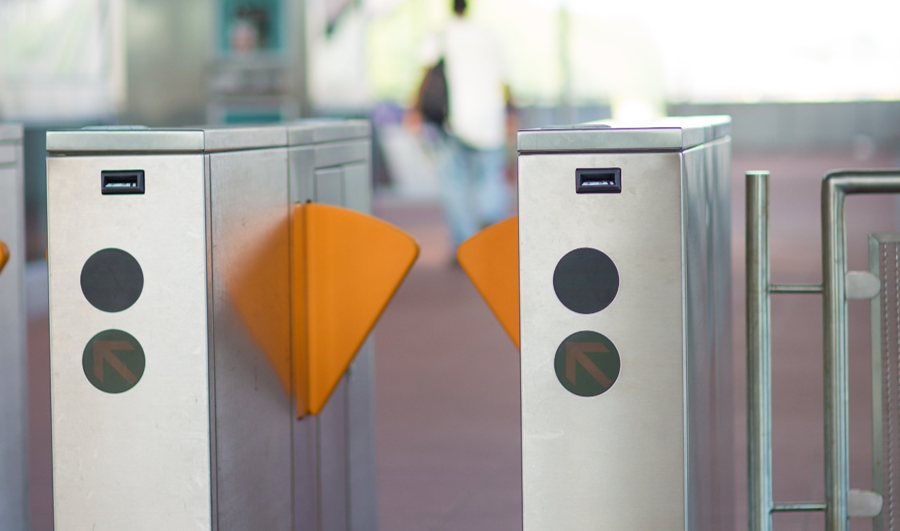Fare evasion is present in every transit system that has fares. Fare evasion estimates vary across transit systems, and vary within those systems by mode. In New York City, for example, the Metropolitan Transportation Authority estimates fare evasion rates to be 18.6 percent of ridership on buses and 5.7 percent on the subway. Fare evasion is difficult to measure, however, because a transit agency needs a “true” count of riders to compare recorded paid fares against, or must use some other method of collecting data on fare evasion, such as random point-in-time inspections and monitoring. True counts are difficult at best, and even then may not distinguish between people who “evade” fares by intent and those who do not pay their full fare for other reasons.
Though the term “fare evasion” implies the intent to avoid paying the required fare, most measures of fare evasion also encompass passengers who board the bus when a farebox is broken, or otherwise fail to pay or tap their SmarTrip card for any reason. In D.C., it often also includes students whose transit rides are covered under D.C.’s Kids Ride Free transit subsidy program but who do not tap their SmarTrip cards, have not received cards, or whose cards have malfunctioned.
Several state and local governments, as well as transit systems across the country, have sought ways to prevent fare evasion in recent years through increased enforcement and harsher penalties, similar to increasing penalties assessed for failure to pay traffic and parking tickets. Others—including the D.C. Council—have moved in the other direction by decriminalizing failure to pay, citing racial disparities in enforcement and signaling an intentional turn against the “broken windows” theory of policing.
Over the past several years, the regionally governed Washington Metropolitan Area Transit Authority (WMATA) has increased its focus on combatting fare evasion on Metrorail and Metrobuses. To wit, WMATA has been increasing enforcement efforts over the last several years, citing stark increases in fare evasion on buses in particular as a threat to revenue. The agency estimated that revenue loss from fare evasion was roughly $40 million in FY 2019: $29 million on Metrobus and $11 million on Metrorail.
Metrorail ridership grew by four percent last year, from 175 million trips in 2018 to 182 million trips in 2019, after several years of declining ridership. Average weekday ridership grew by 3.3 percent, or 20,000 trips per weekday, an average of 262,000 total rides per weekday. Metrobus ridership declined 3.5 percent during this time, from 299,000 average daily farebox boardings in 2018 to 289,000 in 2019, with riders citing service delays as a major reason.
WMATA has some tools to systematically track total ridership on buses, including automatic door sensors and data inputted by drivers, but currently lacks similarly comprehensive methods for Metrorail. The tools on Metrobus are also subject to technical issues and human error, as such systems often are. As a result, the true tally of both unpaid and paid ridership within the system remains difficult to quantify—which also makes it difficult to understand the underlying reasons for fare evasion and how reduce it.
How is fare evasion estimated for Metrobus?
When WMATA reports data on fare evasions on Metrobus, these estimates are generally based on the number of unpaid fares as tracked by bus operators, who are required to record when a rider boards without paying by pressing a key.[1] Based on this approach, WMATA estimated that there were approximately 15 million unpaid bus trips in FY 2019, equivalent to a revenue loss of roughly $29 million, based on what it considers average fare amounts.
Another way WMATA can estimate fare evasion for buses is to use data from automatic sensors built into the front and back doors of each bus. WMATA can then compare the number of paid trips recorded at the farebox at the front of a bus to the number of passengers automatically recorded by the door sensors. The data from the sensors is processed to account for missing or unclear data, and the product is reported as the Automatic Passenger Count (APC). These automatic passenger counts more or less capture the “true” ridership of the bus, but they are also subject to various measurement and data errors.[2]
Based on these measurement approaches, fare evasion data for Metrobus could include:
- Passengers boarding via the front doors without paying, for any reason;
- Passengers boarding via the back doors without paying, for any reason;
- Students who otherwise qualify for free fares under the Kids Ride Free program, but do not tap their SmarTrip cards, do not have card, or whose cards are not working;
- Farebox malfunctions; and
- Passengers getting off the back doors and re-boarding during busy periods.
A 2017 study of Metrobus fare evasion by a group of students and experts at Virginia Tech found that while the five Census Block Groups with the highest number of backdoor Metrobus entries (as measured by WMATA’s APC data) are focused around central D.C. (near George Washington University and the National Mall), as well as other areas with high ridership, such as Anacostia, Rosslyn, and Columbia Heights Metrorail stations. The areas with the highest number of fare evasion trips as recorded by bus driver key presses—which also includes an element of human measurement—were largely concentrated in Ward 8, along with Deanwood in Ward 7.
How is fare evasion calculated for Metrorail?
WMATA does not have a way to calculate system-wide fare evasion rates on Metrorail, and instead bases its estimates on reports and estimates from other transit systems.[3] According to WMATA, “To determine fare evasion on Metrorail, an industry average of the percentage of fare evasion on similar transit properties is applied to the passenger revenue collected. Trips are determined by dividing by an average fare into the assumed missed fare payments.”[4] Using this approach, WMATA appears to have generally assumed fare evasion rates of five percent on Metrorail, representing approximately $11 million in lost revenue for FY 2019, although the exact level depends on the average fare assumed. [Updated 2/20/2020.] The agency reports that this is a “very conservative” estimate.
Though WMATA has not specified which other transit agencies it has looked to for estimating Metrorail fare evasion, other agencies face their own measurement challenges. In New York City, for instance, the Office of the Metropolitan Transportation Authority Inspector General found “areas of concern in the decades-old design” of the New York City Transit (NYCT) system’s fare evasion methods for subway and bus fare evasion, which are based on human observation for randomly selected routes and times. After implementing improved survey procedures, NYCT’s reported estimates for subway fare evasion increased from 3.9 percent in Q2 2019 to 5.7 percent in Q3, while its estimates for bus fare evasion fell from 25.3 percent to 18.6 percent.
WMATA tracks fare evasion warnings and citations issued by the Metro Transit Police Department (MTPD) in Metrorail stations, and also conducts periodic snapshots of fare evasion by watching station camera footage in certain stations; these sources appears to have been used internally to allocate enforcement resources in the absence of more comprehensive data.[5] (Although the D.C. Council decriminalized fare evasion in July 2019, MTPD can still issue civil citations for fare evasion.) Previously, WMATA had also estimated potential Metrorail fare evasion among students by monitoring high-use stations during peak travel times. However, these methods are all vulnerable to a potential feedback loop, where areas targeted for monitoring and enforcement show greater numbers of fare evasion, and are therefore targeted for more monitoring and enforcement.
To have a more complete view of Metrorail ridership, WMATA is currently implementing pilot programs to begin to count passengers (shown below), such as electronic sensors on fare gates and camera-based methods of counting passengers.[6]


Is fare evasion on the rise?
Any transit system with fares will have some level of fare evasion, or otherwise have discrepancies between total ridership and recorded fares. Some riders are unable to pay the full fare due to poverty, some are unwilling to pay in response to poor service or other reasons, and some will have difficulties paying due to overcrowding or technical issues with payment systems. Automated passenger counting systems will also have some level of error and mismeasurement, making precise counts difficult, though they can still show trends in overall ridership over time.
WMATA has estimated a consistent fare evasion rate of 5 percent on Metrorail based on peer systems and industry averages. Its estimates of fare evasion on Metrobuses, as reported by operators’ farebox reports, has risen sharply over the past four years.
However, it is unclear if the increase in fare evasion reports on Metrobus reflects a rising number of unpaid trips, or is related to increasing implementation of fare evasion measurement methods or other issues.[7] In its November 2019 quarterly update (below), WMATA reported increased key presses by bus operators reporting fare evasion from FY 2016 (when the key press appears to have been first introduced[8]) to FY 2019 (the most recent data available). This suggests that the apparent rapid growth in reported fare evasion could be due in part to more widespread implementation of fare evasion measurement as more bus operators are trained and use the approach over time.


Evidence also suggests that a substantial portion of “evaded” fares appear to be trips by young people who are eligible to ride free through Kids Ride Free, a school transit subsidy program in the District of Columbia[9] that allows free school-related bus and rail rides for all D.C. children and youth between the ages of 5 and 21 enrolled in elementary or secondary school. The program was created in SY 2013-2014 as a limited bus benefit, and has been expanded over time to include Metrorail and trips taken outside of school hours.[10]
While Kids Ride Free has led to overall ridership growth for the system,[11] implementation challenges and technical malfunctions have been an ongoing issue for the program, potentially contributing to confusion among students about how the program works.[12] Originally, the program required students to simply show their student ID cards or DC ONE Cards to Metro employees when entering and exiting Metrorail, or when boarding a Metrobus. Later, a change in the program required students to tap their ID cards to record the specific trip, which required a “cumbersome” activation process[13]; another change the following year, in SY 2018-2019, required students to tap registered SmarTrip cards instead.
Most recently, all students’ cards from SY 2018-2019 needed to be replaced for SY 2019-2020 to reflect additional changes in program, but many eligible students were not issued their new SmarTrip cards in time for the new school year. A WTOP investigation in November 2018 showed that this change may have led to a notable drop in recorded ridership—and possible rise in fare evasion reports—when the program change went into effect. At a November 2019 public oversight roundtable, D.C. Councilmember Charles Allen confirmed with WMATA officials who were testifying that problems with D.C.’s Kids Ride Free program led to thousands of instances of recorded fare evasion, as students who were supposed to be able to ride for free were not able to tap their cards, or were told doing so was not necessary.[14]
Fare evasion enforcement efforts focus almost entirely on young Black riders
To date, enforcement efforts undertaken by MTPD have largely focused on young people, almost entirely young Black riders. A 2018 report from the Washington Lawyers’ Committee for Civil Rights and Urban Affairs compiled data on who receives warnings, citations (in Maryland or D.C.), or summons (in Virginia) for fare evasion.[15] The report found that 91 percent of all citations or summons for fare evasion were issued to Black riders. Almost half of all citations or summons—46 percent—were issued to Black youth and young adults under the age of 25.


According a report from the WMATA Board at the October 2019 Northern Virginia Transportation Commission meeting, “rail fare evaders are largely connected to the District of Columbia Public Schools (DCPS), who are already eligible for free bus and rail service.” While WMATA lacks comprehensive data on fare evasion on Metrorail, such statements appear to take into account reports by station managers, as well as the results of Metro Transit Police enforcement actions.
Under this approach, there is a risk that locations will be targeted for enforcement because they have been a focus of enforcement in the past. The Metro Transit Police Department’s enforcement actions on Metrorail appear to be concentrated at Anacostia station and Gallery Place-Chinatown station, based on data on warnings and citations issued in D.C.[16] However, there is evidence that fare evasion occurs at other high-volume stations across the system. In 2016, for instance, WMATA cited both Tenleytown-AU and Anacostia Metro stations as high-use rail stations with particularly high levels of fare evasion as measured by observations of use of unsecured emergency gates.[17]
Other cities and transit systems have shown similar disparities in fare evasion enforcement. In the Seattle metropolitan area, Black riders make up nine percent of Sound Transit riders, but receive 22 percent of warnings, citations, and criminal charges for fare evasion. A report from the Community Service Society on arrests in Brooklyn found that 90 percent of people arrested for fare evasion in early 2017 were Black or Hispanic, and that Black residents were disproportionately represented in arrests compared with their share of Brooklyn’s low-income population. The report also highlighted disproportionate ticketing of Black transit riders in Los Angeles, Minneapolis, and Cleveland, among other cities.
The Washington Lawyers’ Committee report notes that WMATA has not provided more detailed data on the roughly 10,000 people who were stopped for fare evasion during this period but who did not receive a warning, citation, or summons. WMATA has also not specified how many arrests have resulted from fare evasion stops in total, although the agency has separately mentioned at least 2,000 arrests from such stops. The Metro Transit Police Department has stated that about 8 percent of stops resulted in an arrest due to an unrelated warrant.
Addressing “fare evasion” is more than a matter of enforcement
Without a clear understanding of the relative share of total fare evasion attributable to these various causes, it is extremely difficult to estimate how much revenue is actually being “lost” under present conditions, and how much additional revenue could be recaptured. But while more comprehensive data collection and improved collection methods will help form a clearer picture of ridership patterns in D.C. and the metropolitan area, increased farebox collection does not need to be the prevailing policy goal, and increased enforcement does not need to be the main response—particularly if that enforcement would continue to be targeted predominately at D.C.’s young Black residents, as it has in the past. Greater education and outreach, technical improvements, administrative changes, and other approaches may be more likely to address some of the specific issues around subsidized student riders, and broader approaches—from greater transit subsidies to system service improvements—could also address underlying challenges in ways that increase both ridership and revenue over time.
